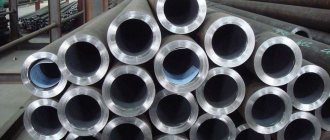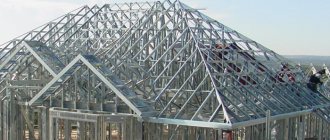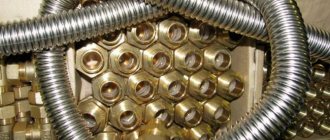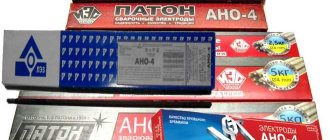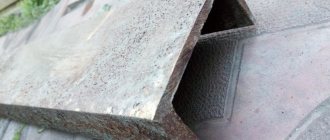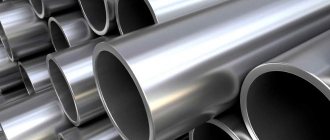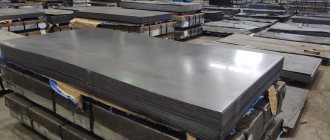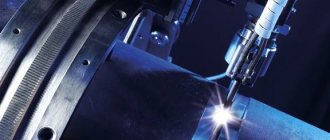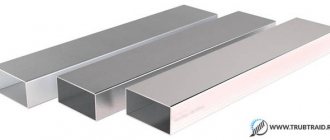- home
- Differences between seamless pipe and electric welded pipe
Seamless pipe
- one-piece metal structure without types of joints. There are several ways to make such structures:
- forging;
- pressing;
- rolling;
- drawing.
The product has increased strength, which is why it is often used in complex structures exposed to different environments. Products without a welded seam are divided into 2 classes:
- hot rolled;
- cold rolled.
Both products are made from the same grades of steel. The difference is that cold rolling helps to achieve better metal surface quality, as well as accuracy in geometry parameters. Hot rolled steel has higher productivity and the price of the final product will be lower.
Due to the high reliability of seamless products, solid rolled metal can be used in complex areas and machine construction industries. In particular, hot-rolled pipes are used in industrial applications. This type of rental is used when the loads on the product greatly exceed the permissible level for the welded type.
Electric welded pipe
- a sample with one seam running along the entire length, made of rolled sheets or strips by molding or welding.
Rolled metal is divided into 4 types:
- straight-seam;
- spiral seam;
- water and gas pipeline;
- profile.
1. Straight seam type is made from metal strips welded at opposite ends, and formed by electric arc or high frequency welding.
2. Large diameter spiral weld type is produced by submerged arc welding.
3. In the production of water-gas electric-welded pipe samples, carbon steel is used as a raw material.
4. Profile products using the electric welding method are manufactured using various metals or alloys, as well as polymer materials.
The method of manufacturing electric-welded pipes is hot-rolled or cold-rolled.
This type has received a wide range of applications: construction, manufacturing of furniture, fences, cars, manufacturing of oil and gas pipelines, pipelines, and other economic/industrial areas.
Product standardization
The difference here is due to different types of GOSTs, where VGP pipes are regulated by state standard No. 3262-75, and the second option No. 10705-80 and No. 10704-91. It is thanks to these instructions that the purpose of the product can already be found in the documents regarding the product item.
Moreover, each such collection of requirements allows us to make the product better and give the owner a longer service life.
Characteristics of seamless rolled metal according to GOST 8732-78
Used steel grades: st.20, 09g2s. The material is resistant to corrosion processes, has high strength and hardness, and is resistant to any climatic conditions.
- Length: from 4 to 12.5 m.
- Weight: up to 162 kg.
- Outer diameter: from 57 to 426 mm.
- Wall thickness: from 3 to 16 mm.
Thin-walled and thick-walled galvanized pipe samples were designed to work with increased loads, with environments of varying degrees of aggressiveness.
Dimensions and technical characteristics
The main similarity between the pipes here is one and it lies in the outer diameter. The remaining components of VGP and ESV pipes are completely different, down to the diameter of the passage hole.
The range of VGP products is very limited and mainly commercial units are presented with a thickness of 2 to 5.5 millimeters, and an outer diameter of up to 165 mm. At the same time, electric-welded pipes can provide up to 1420 millimeters in diameter - it is extremely important for them to withstand powerful pressure relative to themselves.
Scope of application of electric-welded pipes
The quality for which electric-welded pipe is especially valued is its exceptional versatility of use. This primarily concerns round products, which are successfully used by industrial enterprises and construction organizations, as well as in the installation of pipelines, furniture production and the creation of interiors for modern residential and commercial premises. In addition, electric welded pipe is often used as a consumable material for the production of various products.
How widespread pipes of this type are can be judged by the fact that they are found almost everywhere: fencing of buildings and territories, stair railings, awnings, canopies and public transport stops, street benches, etc. The high quality of steel pipes is evident. straight-seam electric welded, evidenced by the fact that they are successfully used for the installation of pipelines through which chemically aggressive liquids and media heated to high temperatures are transported.
Production, materials and assembly method
Although at first it seems that both types of equipment are made according to the same principle with the same materials, namely carbon steel, the varieties with the abbreviations SP, PS, KP, and so on are best suited for water and gas pipes. ES variations use hard steel grades that are resistant to even maximum mechanical stress.
The products are similar in manufacturing technology - VGP pipes are formed from sheet metal by welding, with the addition of a reinforced weld. A similar technique works with electric welded structures.
Production technology
The technological process by which electric-welded pipes are manufactured consists of a number of operations. It is quite complex, labor-intensive and time-consuming. In order for an electric-welded pipe to acquire its finished appearance, it is rolled from a strip of alloy steel (strip), which was previously produced by cold or hot deformation.
To produce high-quality and reliable pipes of different diameters, radio frequency welding is mainly used, which allows, among other things, to carry out the process of joining metal at a fairly high speed. With this welding method, high voltage currents are passed through a pre-rolled workpiece, which contributes to the rapid heating of its edges. In order for a reliable weld to form at the site of the heated and molten edges of the workpiece, they are pressed against each other under great pressure. In order to obtain a blank for an electric-welded pipe of the required diameter from a steel strip (strip), special crimping machines are used.
This technology, which uses specialized enterprises to produce straight-seam and spiral-welded electric-welded steel pipes, allows not only to obtain high-quality and reliable products, but also to provide them with an attractive appearance (the weld seam on such products is almost invisible).
Technological process for the production of welded pipes
Pros and cons of products
For a better understanding, let's present the pros and cons in the form of lists. So, the advantages of VGP structures are as follows:
- Protection from biological and chemical irritants;
- Increased strength;
- Ease.
The only disadvantage that can be noted is the increased conductivity of the metal to electricity.
ES pipes are inferior here in all respects:
- Susceptibility to corrosion.
- Reduced strength.
- Narrowly focused specialization - when such pipes are used in the wrong place, they quickly become unusable.
But even so, these products have increased resistance to mechanical stress and are chemically inert, and therefore, with the proper approach, they can serve the owner for many decades.
Advantages and disadvantages
All the technological difficulties and costs in the production of straight- and spiral-seam types of products are incomparable with the efforts expended on the production of seamless ones. Hence the main advantage of electric welded products is cost.
Another undoubted advantage is its large diameter, which can even be 100 or more times the thickness of the walls. This makes it lighter and easier to transport.
The technology for manufacturing straight-seam pipes allows you to create both round and profile types of products (rectangular, square).
Some disadvantages are still present - according to GOST standards, welded pipes can withstand pressure much less than seamless ones. They also cannot be bent, and therefore, if you need to change the direction of a water or gas pipeline made from them, you cannot do without fittings.
Conclusion
Welded pipelines are used in the development of various utility networks, complex innovative systems and the construction of buildings. When compared with all-metal similarities, they have low weight, lower cost and less significant discrepancies in thickness. Welded pipe can be designated according to a variety of parameters, but its zoning by direction is considered the most common. In accordance with this, structural, pipeline and main products are distinguished. The first of them are used for construction, the second - in the development of utility networks and innovative systems, the third - in gas and oil pipelines. In the production of welded rolled products, furnace welding technologies, electric welding are used, and shielding gas welding is also used. The first method is considered quite popular, because it is the least expensive and makes it possible to produce thin-walled products. The highest quality connection is guaranteed by welding in shielding gas
Moreover, it is considered the most expensive method. You can find out additional information on this topic by watching the video in this publication.
Manufacturing methods
Welded pipes are made using three technologies:
- Furnace welding. The blanks, called strips, are heated in a tunnel furnace to 1300˚ After leaving it, the edges are blown with hot air, raising their temperature to 1400˚C while simultaneously blowing off scale. Then the workpiece is processed on a forming and welding mill, giving it the desired shape. After the secondary blowing of the edges with hot air, they are welded together. The workpiece passes through the oven again, then the seam is pressed using forming rollers to improve quality. Products produced using this technology are classified as hot-deformed.
- Electric welding. This is the most common method, as it allows you to make thin-walled products of large diameters. The seams are made using submerged arc welding. Pipe blanks from cold strips are produced at a rolling mill using the roll forming method. Hemispheres for straight-seam types of large diameter are made by compression molding. Spiral seam blanks are produced on roller-mandrel or bushing mills. After welding the edges, a straight or spiral-shaped seam is formed on the surface. After it is cleaned and cooled with water, the workpiece is transferred to a sizing mill, where the diameter is adjusted along the entire length. Then the quality of the seam is checked visually and ultrasound, after which hydrotests of its strength are carried out. If, after another ultrasound scan, no defects are found, the electric-welded pipes are sent to the finished product warehouse.
- Welding in an inert gas environment. This technology produces options from alloy and stainless steel. During conventional welding, the quality of the weld decreases due to the carbidization of alloying additives that occurs when interacting with atmospheric oxygen. To eliminate this phenomenon, the welding site is protected with argon, helium, and carbon dioxide. The weld is created by melting with an electric arc a filler wire made of the same material as the pipe. Welding is carried out with a non-consumable tungsten electrode. Products created using this and previous technology are classified as cold-formable.
How to identify a seamless pipe
The answer to the question of what seamless pipes means lies in the very name of this type of product. Regardless of the method of joining the pipe seam (electric arc, furnace or induction welding), it leaves a mark. If you don't know how to identify a seamless pipe, inspect its outer surface and ends.
A continuous seam line is clearly visible on the external surface, unless it is a galvanized pipe. The absence or presence of a seam is also easy to determine on a fresh cut of the pipe end. It will be visible throughout the entire depth of the cut. Since seamless pipe is made from a single piece, there cannot be any seam on it.
Regardless of the type of pipes, all of them are subjected to hydraulic tests. At the same time, not only the quality of the seam of welded pipes is checked, but also the quality indicators of the metal. Tests are carried out by the manufacturer using special equipment and documented with appropriate protocols in accordance with the requirements of GOSTs regulating product quality control.
The manufacturer bears full responsibility for the accuracy of the information specified in the documents. It is almost impossible to make a mistake in identifying a seamless pipe, even in the absence of factory markings - it is enough to measure the wall thickness. For example, a pipe with an outer diameter of 20 mm with a wall thickness of 2.5 mm or more is a seamless product.
Materials for production
Welded pipe rolling is made from sheet steel up to 5 cm thick or tape rolled into rolls. For manufacturing, manufacturers use carbon or low-alloy iron. Depending on the percentage of carbon, steel is divided into low, medium and high carbon grades. The more it is, the stronger the metal. However, at low temperatures, high-carbon steel becomes brittle, which limits its scope of application.
Low-alloy metal, containing no more than 2.5% alloying additives, maintains high strength over a wide temperature range. This makes it possible to reduce weight by reducing wall thickness. Such welded pipes are more expensive than those made from plain steel. However, due to reduced wear and increased resistance to corrosion, service life increases. Therefore, the costs are more than compensated. Welded stainless steel pipes are made from cold-rolled (thickness 0.4 - 5 mm) or hot-rolled (2 - 50 mm) sheet steel.
Comparison of straight-seam and spiral-seam pipes
Rolled pipe with a straight seam is cheaper because it is easier to manufacture. It is universal in use. It is used in heating systems, water supply, sewerage, as support structures, etc. Available in different types, differing in diameter and wall thickness. You can buy electric welded pipes inexpensively on our website.
Spiral welded pipes are more expensive, but they are also stronger. The products have large diameters, which allows them to be used for laying pipelines.
Advantages of welded pipe material
Rolled pipes created by welding have important positive qualities. Let us explain them in detail:
- Cost-effective - the latest technologies make it possible to make the most reliable welded joints. Thanks to them, a pipe created by welding is in no way inferior to all-metal samples. This makes it possible to install it where previously only seamless products could be used. This leads to big savings because the cost of prefabricated products is much less than their cast substitutes;
- Low weight - welded structures, when compared with all-metal samples, have much thinner walls, which greatly reduces the weight of the product. As a result, the process of transporting and future installation of components becomes easier. After all, this will require less participation of equipment and people;
- Smaller deviations in thickness - this can be explained by the fact that welded products are created from steel based on a sheet, which is considered the same along its entire length. The clarity of the shapes makes the process of installing the welded product easier.
Which option to choose
The main difference between welded and seamless pipes is the maximum permissible pressure. According to state standard 10705, sutures can withstand up to 160 atm. GOST for seamless pipes contains a maximum value of 200 atm. At the same time, the standard for communications in a multi-story building is 16 atmospheres. In private houses - only 2-3 atm. This explains the main difference in the use of welded and seamless pipes. In most cases, there is simply no point in spending money on more expensive all-metal products.
